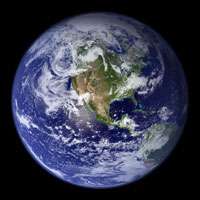March 2, 2012 report
Earth's makeup found to be more diverse than previously thought

(PhysOrg.com) -- For most of modern science, researchers have believed that the Earth was primarily made up of enstatite chondrites, a subclass of meteorites. This was because of the similarity of chromium, nickel and oxygen isotope proportions found on Earth as they compared to enstatite chondrites. Now however, new research by a pair of French geochemists studying silicon isotopes found on Earth, the moon and several types of meteorites, suggest, as they describe in their paper published in Science, that the ingredients that make up the Earth are likely more diverse.
Most researchers believe that the formation of the Earth began as particles left over from the formation of the sun clumped together due to gravity. After that, the Earth accreted as it was struck by meteorites, which up until now, were believed to be mostly enstatite chondrites. After billions of years of new material being added, the Earth eventually grew to its present size. This new research suggests that more types of meteorites were involved in that process than has generally been thought.
The two geochemists, Bernard Bourdon and Caroline Fitoussi had a hunch that there was likely more to the story, so they began collecting samples from a variety of Earth mantle rocks focusing specifically on silicon isotopes. They then applied the same kind of attention to samples of rocks brought back from the moon. Next, they compared their findings with two kinds of meteorites that have been found on the Earth’s surface: Enstatite chondrites and enstatite achondrites. They followed all that up by feeding all of their information into a computer model that simulated the formation of the Earth and found that a mixture of at least three types of meteorites could have led to the amounts of chromium, nickel and oxygen isotopes we find today but could also explain the amounts of silicon isotopes found in all the rocks they studied.
Because of this, they say, it appears likely that the Earth accreted from more kinds of meteorites than has been suggested by previous studies, which means its composition is likely more varied than has generally been thought.
In addition, as part of their study, they noted that silicon isotope measurements between Earth and moon samples were so similar that it appears likely that the moon was made from the same material as the Earth’s mantle, which gives credence to the theory that the moon was once a part of the Earth but was torn away by a very large asteroid strike at some later date.
More information: Silicon Isotope Evidence Against an Enstatite Chondrite Earth, Science DOI: 10.1126/science.1219509
ABSTRACT
The compositions of Earth materials are strikingly similar to those of enstatite chondrite meteorites in many isotope systems. Although this suggests that Earth largely accreted from enstatite chondrites, definitive proof of this model has been lacking. By comparing the Si isotope signatures of several extraterrestrial materials with terrestrial samples, we show that they cannot be explained by core formation scenarios involving a bulk Earth of enstatite chondrite composition. Si isotope similarities between the bulk silicate Earth and the Moon preclude the existence of a hidden reservoir in the lower mantle, a necessary condition of the enstatite chondrite model, and require an equilibrium process after the Moon-forming impact. A three-endmember chondritic mixing model for the Earth reconciles the Si isotope similarities between enstatite chondrites and Earth.
Journal information: Science
© 2011 PhysOrg.com
















